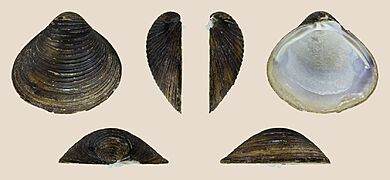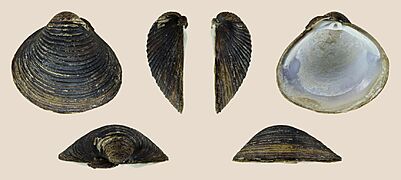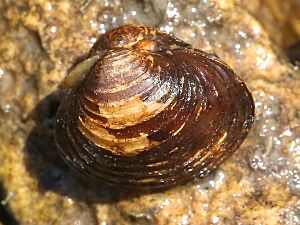Corbicula fluminea facts for kids
Quick facts for kids Corbicula fluminea |
|
|---|---|
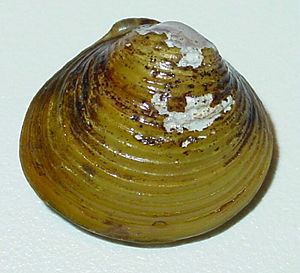 |
|
| Corbicula fluminea | |
| Conservation status | |
| Scientific classification | |
| Synonyms | |
|
Tellina fluminea O. F. Müller, 1774 (original combination) |
The Corbicula fluminea, also known as the Asian clam or golden clam, is a type of freshwater clam. It originally comes from eastern Asia and parts of Africa. However, it has spread to many other places around the world, like North America, South America, Europe, and New Zealand, where it has become an invasive species. This means it's a species that has moved to a new area and is causing harm to the environment there.
Contents
What is the Asian Clam?
The Asian clam is a very successful aquatic invasive species. It has spread to new places like South America, North America, and Europe. People believe that human activities, especially ships carrying water in their ballast tanks, have helped these clams travel around the world. In some countries like Japan and China, Asian clams are eaten by people.
The shell of the Asian clam is usually yellow-green, brown, or black. You can often see rings on the shell that show how it has grown. The inside of the shell has a light purple color.
How Asian Clams Eat
Asian clams are filter feeders. This means they clean the water by sucking it in and filtering out tiny bits of food. They mostly eat phytoplankton, which are like tiny plants floating in the water. They can also feed on organic matter found in the sand or mud at the bottom of rivers and lakes.
Because they filter water, they can also absorb a lot of toxins from polluted water. For example, clams found in New Zealand's Waikato River are not safe to eat because of pollution in the river. After feeding, these clams release chemicals like nitrogen and phosphorus, which can affect the water quality.
Why Asian Clams are a Problem
Asian clams are very good at reproducing and spreading. They can grow in large numbers in rivers and lakes. They can be carried by water currents or by people moving boats and equipment. This allows them to take over habitats and food sources from native animals, like other types of clams and mussels.
These clams can also cause problems for human structures. They can clog up water treatment plants and hydroelectric dams, which are important for providing clean water and electricity.
Life Cycle and Reproduction
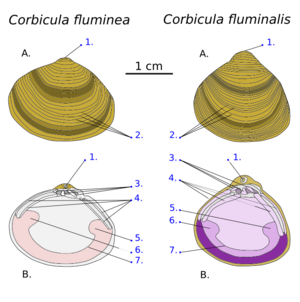
Asian clams are special because they are hermaphrodites. This means each clam can produce both eggs and sperm. They can even fertilize themselves! They start producing eggs and sperm soon after they become adults.
A single clam can release many tiny larvae (baby clams) every day, sometimes more than 570 larvae per day. Over a year, one clam can release over 68,000 larvae. These tiny larvae are about 200 microns long (that's super tiny!). They float in the water until they settle down and become sessile adults, meaning they stay in one place. Adult clams can grow to about 5 centimeters (2 inches) long.
Where Asian Clams Live
Native Homes
The Asian clam naturally lives in freshwater areas of Eastern Asia. This includes countries like Russia, Thailand, the Philippines, China, Taiwan, Korea, and Japan. They are also found naturally in parts of Africa.
Spreading Around the World
Asian clams have spread widely, especially in coastal rivers where there is a lot of shipping activity. Here are some places where they have become an invasive species:
- British Columbia, Canada (since around 1924)
- The Columbia River in the United States (since 1938)
- The River Thames in the UK (since 2004)
- Cuba
- Lake Tahoe in California and Nevada (first found in 2002)
- Lake George, New York, USA
- Many countries in South America, including Argentina, Uruguay, Brazil, Peru, Venezuela, and Ecuador.
- Germany's Rhine River (late 1980s)
- The Danube River
- The Elbe River (since 1998)
- Rivers in the Republic of Ireland (since 2010)
- Czech Republic (since 2000)
- Slovakia
- Minho River in Portugal
- Briggs Lake in Minnesota, USA (found in 2020, but they might not survive cold winters there)
- Shuswap Lake, British Columbia, Canada (found in 2020)
- Pend d'Oreille River in British Columbia (found in 2021)
- The Waikato River in New Zealand (first found in May 2023). Many lakes and rivers in New Zealand were closed as a safety measure to stop the clams from spreading further.
How Asian Clams Spread
Human Help
Human activities are the main reason Asian clams have spread so far.
- Food Source: They might have first come to North America in the 1920s with Asian immigrants who used them as food.
- Ballast Water: Ships often carry water in their ballast tanks for balance. This water can contain tiny clam larvae, which are then released in new ports.
- Boats and Aquariums: People using recreational boats can accidentally carry clams or larvae to new lakes. Also, Asian clams are sold for aquariums, and sometimes people release them into the wild.
Clam Superpowers
Asian clams have several natural abilities that help them invade new places:
- They grow very fast.
- They become adults and can reproduce quickly.
- They have a short lifespan but produce many babies.
- They filter water very quickly to get food.
- They can spread their larvae far away using water currents.
- They can live in many different types of habitats, from sandy to muddy bottoms.
Because they can fertilize themselves and produce many larvae that float in the water, Asian clams can quickly take over new areas.
Where They Like to Live
Asian clams seem to thrive in certain conditions. They are often found in areas with coarser sand. They are usually found in places that are:
- Below 500 meters (about 1,640 feet) in elevation.
- Between 30° and 55° latitude (which means they prefer temperate climates).
- Where the winter temperature doesn't drop below -10°C (14°F).
Impact on Ecosystems
Asian clams change the sediment (mud and sand) where they live by moving it around. This activity can negatively affect other animals that live on the bottom of rivers and lakes.
When they excrete chemicals like nitrogen and phosphorus, it can cause an imbalance in the water. This can lead to too much algae and cyanobacteria (blue-green algae) growing, which can harm the water quality and other aquatic life.
These clams can also remove a lot of phytoplankton from the water. In some rivers, they have removed up to 70% of the phytoplankton, which is a major food source for many other creatures. This can also lead to lower oxygen levels in the water, causing problems for fish and other animals.
The biggest problem for humans is that Asian clams can cause billions of dollars in damage. They clog pipes, heat exchangers, and other parts of water systems. Ecologically, they cause native clams, which are often already at risk, to decline or even disappear.
Global Spread Pattern
The first time Asian clams were officially recorded in the Western Hemisphere was in British Columbia around 1924. From there, they spread across the Pacific Northwest and then through the southern United States into South America. They appeared more recently in Europe and Central America, starting in Caribbean countries in 1998.
When Asian clams were found in New Zealand's Waikato River in May 2023, experts believed they had been there for several years already. Because it's so hard to get rid of Corbicula once they are established, it's thought that removing them completely from New Zealand will be almost impossible.
What Can Be Done?
Asian clams have been linked to harmful algal blooms. There are also worries that they will outcompete and replace native species like the montane pea clam and the ramshorn snail.
Some efforts are being made to control them:
- At Lake Tahoe, people are trying to smother the clams on the lake bottom with rubber mats.
- In August 2020, several boats in Wyoming were found to be heavily infested with C. fluminea.
- In October 2020, officials in Montana suggested draining Lake Elmo to dry out and freeze the clams, hoping to kill them.
See also



